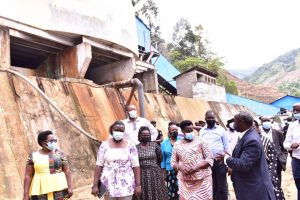Government is planning to re-open the defunct Kilembe copper mine which is estimated to contain 4.5 million ton of ore, where an investor will also be sought immediately.
This was announced by Vice President Maj (Rtd) Jessica Alupo, during her inspection of Kilembe Mines on Wednesday.
The Vice President directed the Ministry of Energy and Mineral Development to immediately initiate a process to get an investor, who will come and take over the management and operationalization of Kilembe Mines.
“The Ministry of Energy and Mineral Development, within the shortest time possible, should advertise the Expression of Interest for an investor, Please let it be transparent, as Government, the revamp of the infrastructure, the investor will also be handling the exploration and mining,” Alupo said.
She also directed the Uganda National Roads Authority and the Ministry of Works and Transport, to expedite the reconstruction of Kyanjuki Bridge at Kilembe Mines.
The bridge connects to the richest copper mine, according to Alupo, this bridge will also help tourists to also easily reach the highest point of the Rwenzori Mountains, Mt. Stanley’s Margherita Peak.
Alupo advised the Ministry of Water and Environment to do their part, by taming river Nyamwamba, so that when the bridges are constructed, the river will be able to follow its original route, and will not affect communities, or people crossing from one point to another.
She added, “I will table a proposal before the President, to get money and pay the people who work for Kilembe mines, who are now working as volunteers to keep assets of the mines; who have not been receiving their payments, for a long time. We will propose to the President, to get money and pay those arrears.”
There are seven staff in top management and 131 other employees, supported by a seven-member Board of Directors, whose salaries and allowances have accumulated to about sh2bn.
The mine, during 1956 to mid-1960s is reported to have been vibrant and it accounted for up to 30% of Uganda’s foreign export earnings. It was the country’s third-highest export-earning venture, coming only after coffee and cotton.
Once a major producer of copper and cobalt, Kilembe was abandoned by Canadian firm Falconbridge in the 1970s when Uganda’s economy stagnated. The mine started making losses in the 1970s due to lack of recapitalization, rampant inflation, and the global collapse of copper prices at the time, which drove away foreign investors.
The government became the major shareholder in 1975 and copper production ceased in 1982; when it was no longer economically viable.
Previous government efforts to revive the mine, near Uganda’s border with the Democratic Republic of Congo; between 1983 to 2006 had not yet yielded.
However, Experts say Kilembe Mines has great potential, according to Uganda’s Department of Geological Survey and Mines, there are proven reserves of ore estimated to be 1.77 percent pure copper and 0.17 percent cobalt.
More so, an estimated 5.5 million tons at an average grade of 0,171% copper and o.114 cobalt were left above ground in dams as tailings despite being partly eroded by the recent river Nyamwamba floodwaters.
When protected, these tailings are expected to supplement metal recoveries and enhance cash flow when Kilembe Mines resume.
Based on this, the Government, according to Alupo, is now determined to redevelop the Kilembe Mine, which sits on the foothills of the Rwenzori mountains.
Alupo, also revealed that government will reconstruct Kilembe Hospital which serves several vulnerable people, whose property were razed down by river Nyamwamba.
A total of 10 secondary and primary schools were razed down by river Nyamwamba last year, Alupo said that there are plans, to get funds, and revive these schools.
The Vice President was accompanied by the State Minister for Disaster Preparedness Peter Lokeris, the State Minister in the Vice President’s Office Diana Mutasingwa, the State Minister for National Guidance Godfrey Kabyanga, and the State Minister for Trade, Industry, and Cooperatives Harriet Ntabazi.
The team also included the Principal Private Secretary in the Office of the Vice President Alex Kakooza, the Permanent Secretary in the Ministry of Energy and Mineral Development Irene Batebe, the UNRA Executive Director Allen Kagina, the Executive Director of Uganda Investment Authority Robert Mukuza, and the Engineer in Chief in the Ministry of Works and Transport Sam Bagonza and some Members of Parliament from the Kasese District.








